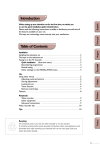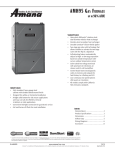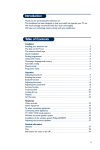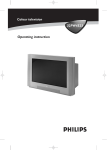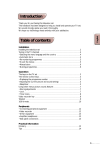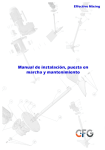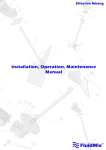Download Philips 29PT5516/01 Flat Panel Television User Manual
Transcript
Introduction Thank you for purchasing this television set. This handbook has been designed to help you install and operate your TV set. We would strongly recommend that you read it thoroughly. We hope our technology meets entirely with your satisfaction. Table of Contents Installation Installing your television set . . . . . . . . . . . . . . . . . . . . . . . . . . . . . . . . . . . . . . . . . .2 The keys on the TV set . . . . . . . . . . . . . . . . . . . . . . . . . . . . . . . . . . . . . . . . . . . . . .2 The remote control keys . . . . . . . . . . . . . . . . . . . . . . . . . . . . . . . . . . . . . . . . . . . .3 Quick installation . . . . . . . . . . . . . . . . . . . . . . . . . . . . . . . . . . . . . . . . . . . . . . . . . .4 Sorting programmes . . . . . . . . . . . . . . . . . . . . . . . . . . . . . . . . . . . . . . . . . . . . . . . .4 EasyLink function . . . . . . . . . . . . . . . . . . . . . . . . . . . . . . . . . . . . . . . . . . . . . . . . . . .4 Using other menus . . . . . . . . . . . . . . . . . . . . . . . . . . . . . . . . . . . . . . . . . . . . . . . . .5 Choosing a language and country . . . . . . . . . . . . . . . . . . . . . . . . . . . . . . . . . . . . .5 Automatic tuning . . . . . . . . . . . . . . . . . . . . . . . . . . . . . . . . . . . . . . . . . . . . . . . . . .5 Manual tuning . . . . . . . . . . . . . . . . . . . . . . . . . . . . . . . . . . . . . . . . . . . . . . . . . . . . .6 Programme name . . . . . . . . . . . . . . . . . . . . . . . . . . . . . . . . . . . . . . . . . . . . . . . . . .6 Operation Adjusting the picture . . . . . . . . . . . . . . . . . . . . . . . . . . . . . . . . . . . . . . . . . . . . . . .7 Adjusting the sound . . . . . . . . . . . . . . . . . . . . . . . . . . . . . . . . . . . . . . . . . . . . . . . .7 16:9 Formats . . . . . . . . . . . . . . . . . . . . . . . . . . . . . . . . . . . . . . . . . . . . . . . . . . . . . .7 Timer function . . . . . . . . . . . . . . . . . . . . . . . . . . . . . . . . . . . . . . . . . . . . . . . . . . . .8 Locking the set . . . . . . . . . . . . . . . . . . . . . . . . . . . . . . . . . . . . . . . . . . . . . . . . . . . .8 Teletext . . . . . . . . . . . . . . . . . . . . . . . . . . . . . . . . . . . . . . . . . . . . . . . . . . . . . . . . . .9 NexTView Guide . . . . . . . . . . . . . . . . . . . . . . . . . . . . . . . . . . . . . . . . . . . . . . . . . .10 NexTViewLink Function . . . . . . . . . . . . . . . . . . . . . . . . . . . . . . . . . . . . . . . . . . . .10 Peripherals Video recorder . . . . . . . . . . . . . . . . . . . . . . . . . . . . . . . . . . . . . . . . . . . . . . . . . . .12 Other equipment . . . . . . . . . . . . . . . . . . . . . . . . . . . . . . . . . . . . . . . . . . . . . . . . .12 To select connected equipment . . . . . . . . . . . . . . . . . . . . . . . . . . . . . . . . . . . . .12 Connecting other appliances . . . . . . . . . . . . . . . . . . . . . . . . . . . . . . . . . . . . . . . .13 TV / VCR / DVD mode selector . . . . . . . . . . . . . . . . . . . . . . . . . . . . . . . . . . . . . .13 Practical information Tips . . . . . . . . . . . . . . . . . . . . . . . . . . . . . . . . . . . . . . . . . . . . . . . . . . . . . . . . . . . .14 Glossary . . . . . . . . . . . . . . . . . . . . . . . . . . . . . . . . . . . . . . . . . . . . . . . . . . . . . . . .14 ° Recycling The materials used in your set are either reusable or can be recycled. To minimise environmental waste, specialist companies collect used appliances and dismantle them after retrieving any materials that can be used again (ask your dealer for further details). 1 Installing your television set & Positioning the television set “ Place your TV on a solid, stable surface, leaving a space of at least 5 cm around the appliance. To avoid accidents, do not put anything on the set such as a cloth or cover, a container full of liquid (vase) or a heat source (lamp).The set must not be exposed to water. é Connections • Insert the aerial plug into the : socket at the rear of the set. • Insert the mains plug into a wall socket (220240 V / 50 Hz). Remote control Insert the two R6-type batteries (supplied) making sure that they are the right way round. Check that the mode selector is set to TV. The batteries supplied with this appliance do not contain mercury or nickel cadmium. If you have access to a recycling facility, please do not discard your used batteries (if in doubt, consult your dealer). When the batteries are replaced, use the same type. ‘ Switching on To switch on the set, press the on/off key. A red indicator comes on and the screen lights up. Go straight to the chapter Quick installation on page 4. If the television remains in standby mode, press P # on the remote control. The indicator will flashe when you use the remote control. The keys on the TV set The television set has 4 keys which are located on the front or the top of the set depending on the model. 2 The VOLUME - + (- ” +) keys are used to adjust sound levels. The PROGRAM - + (- P +) keys are used to select the required programmes. To access the menus, simultaneously hold down the ” - and ” + keys.The PROGRAM - + keys may then be used to select an adjustment and the - ” + keys to make that adjustment. To exit from the menus, hold down the 2 ” - and ” + keys. Note: when the CHILD LOCK function is activated, these keys are unavailable (refer to FEATURES menu on page 8). The remote control keys List of programmes To display/clear the list of programmes. Use the keys IJ to select a programme and the key L to display it. The symbol + is displayed alongside all programmes which are locked (p.8) or ? if they are not locked. Sleeptimer To select the length of time before the set automatically switches to standby (from 0 to 240 minutes) Select EXT sockets Press several times to select EXT1, EXT2 and EXT3, S-VHS2 and S-VHS3. Mode selector (p. 13) To activate the remote control in TV,VCR (video recorder) or DVD mode. Smart sound controls To access a series of settings: VOICE, MUSIC,THEATRE and return to PERSONAL Menu To display or exit from the menus Cursor These 4 keys are used to move within the menus or to have direct access to the 16:9 formats (p 7). Volume To adjust the sound level Mute To disable or enable the sound. Teletext features (p. 9) Sound mode To switch from STEREO to MONO or to choose between Dual I and Dual II for bilingual transmissions. For TV sets fitted with NICAM reception, depending on the transmission, you can switch from NICAM STEREO to MONO or choose between NICAM DUAL I, NICAM DUAL II and MONO. When the sound mode is switched to MONO, the indication is displayed in red. Contrast + To activate / de-activate the automatic contrast adjustment system (the dark areas are made darker whilst maintaining the detail). Standby To set the TV to standby mode. To switch the TV set on again, press P @ # or 0 9. NexTView Guide (p. 10) Numerical keys For direct access to programmes. For a 2 digit programme number, the 2nd digit must be entered before the dash disappears. Smart picture controls To access a series of settings: RICH, NATURAL,SOFT, MULTIMEDIA and return to PERSONAL. Surround sound To activate /deactivate the surround sound effect. In stereo, this gives the impression that the speakers are further apart. For models equipped with Virtual Dolby Surround*, you can obtain Dolby Surround Pro Logic sound quality. In mono, a stereo spatial effect is simulated. * Manufactured under license from Dolby Laboratories Licensing Corporation.”Dolby” ”Pro Logic” and the double-D symbol £ are trademarks of Dolby Laboratories Licensing Corporation. Selecting TV programmes To move up or down a programme. The number, (the name) and the sound mode are displayed for a few seconds. For some TV programmes the title of the programme appears at the bottom of the screen. Screen information To display / remove the programme number, the name (if it exists), the time, the sound mode and the time remaining on the timer. Hold down for 5 seconds to permanently display the programme number on the screen.The volume level and the smart control adjustments are then displayed each time they are used. Previous programme To access the previously viewed programme. 16:9 formats (p. 7) 3 Quick installation The first time you switch on the television, a menu appears on the screen and the tuning starts automatically. SELECT LANGUAGE LANGUAGE COUNTRY • ENGLISH DANSK NEDERLANDS FINNISH FRANCAIS AUSTRIA BELGIUM SWITZERLAND GERMANY DENMARK SEARCHING PLEASE WAIT PROG. NO. 2 215.18 MHZ If the menu does not appear, hold down the ” and ” + keys on the set for 5 seconds to start the tuning. The operation takes several minutes. A display shows the search status and the number of programmes found.When it has finished the menu disappears. To exit or interrupt the search, press the H key. If no programmes are found, refer to the chapter entitled Tips on p. 14. & If the transmitter or the cable network broadcasts the automatic sort signal, the programmes will be correctly numbered. é If not, the programmes found will be numbered in descending order starting at 99, 98, 97, etc. Use the SORT menu to renumber them. Some transmitters or cable networks broadcast their own sort parameters (region, language, etc.). Where this is the case, make your choice using the IJ keys and confirm with L. Sorting programmes & Press the H key.The main menu is displayed. é Select INSTALL (J), then press L. The INSTALL menu appears. • PICTURE • SOUND • FEATURES • INSTALL INSTALL • LANGUAGE • COUNTRY • AUTO STORE • MANUAL STORE • SORT • NAME FROM TO EXCHANGE “ Using the J key, select SORT then press L. The SORT menu appears.The FROM option is activated. Note: this menu works as follows: • Change "FROM" (enter the current programme number), • "TO" (enter the new number), • EXCHANGE numbers" (the operation is carried out). EasyLink function (only available on certain versions) If the set is connected (by the EXT2 socket) to a video equipped with the EasyLink function, the language, country and channels found are automatically transmitted to the video recorder at the time of installation.A 4 ‘ Select the programme you wish to renumber using KL keys or 0 to 9. Example: to renumber programme 78 as 2 press 7 8. ( Select TO (using J key) and enter the new number with KL keys or 0 to 9 (for the example given, enter 2). § Select EXCHANGE (J key) and press L. The message EXCHANGED appears, the exchange takes place. In our example, programme 78 is renumbered as 2 (and programme 2 as 78). è Select the option FROM (I key) and repeat stages ‘ to § as many times as there are programmes to renumber. See also: EasyLink function below. ! To exit from the menus, press R. message is displayed on-screen during loading. The list of video recorder channels is then the same as those of the set. The EASY LINK setting in the OPTIONS menu must be set to ON (default setting), see page 10. Using other menus PICTURE • BRIGHTNESS • COLOUR • CONTRAST • SHARPNESS • STORE --I------ 39 Choosing a language and country & Press the H key to display the main menu. é Select INSTALL (J), then press L. The INSTALL menu appears. The LANGUAGE option is activated. • PICTURE • SOUND • FEATURES • INSTALL INSTALL • LANGUAGE • COUNTRY • AUTO STORE • MANUAL STORE • SORT • NAME ENGLISH DANSK NEDERLANDS “ Press L to go into the LANGUAGE menu. ‘ Select your language with the IJ keys. The menus will appear in the chosen language. ( Press K to exit the LANGUAGE menu. § Select the option COUNTRY and press L. è Select your country with IJ keys (GB). If your country does not appear in the list, select OTHER. ! Press K to exit the COUNTRY menu. ç To exit from the menus, press R. See also: EasyLink function, page 4. Automatic tuning This menu allows you to automatically search for all the programmes available in your region (or on your cable network). & First carry out operations & to ! above, then: é Press J once to select AUTO STORE then press L.The search begins. After several minutes, the INSTALL menu reappears automatically. INSTALL • LANGUAGE • COUNTRY • AUTO STORE • MANUAL STORE • SORT • NAME SEARCHING PLEASE WAIT PROG. NO. 215.18 MHZ 2 “ If the transmitter or the cable network broadcasts the automatic sort signal, the programmes will be correctly numbered. ‘ If not, the programmes found will be numbered in descending order starting at 99, 98, 97, etc. Use the SORT menu to renumber them. Some transmitters or cable networks broadcast their own sort parameters (region, language, etc.). Where this is the case, make your choice using the IJ keys and confirm with L. To exit or interrupt the search, press the H key. If no picture is found, refer to the chapter entitled Tips on p. 14. See also: EasyLink function, page 4. ( To exit from the menus, press R. 5 Manual tuning This menu allows you to store the programmes one by one. & Press H. é Select INSTALL (J), then press L. The INSTALL menu appears. “ Select MANUAL STORE (J) then press L. The menu appears : • PICTURE • SOUND • FEATURES • INSTALL INSTALL MANUAL STORE • SYSTEM • SEARCH • PROG. NO. • FINE TUNE • STORE EUROPE WEST EUR EAST EUR UK FRANCE ‘ Press L to go to the SYSTEM menu. Use IJ to choose EUROPE* (automatic detection) or manual detection with WEST EUR (standard BG reception), EAST EUR (standard DK reception), UK (standard I reception) or FRANCE (standard LL'). Then press K to exit from the menu. * Except for France (standard LL'): select the option FRANCE. ( Select SEARCH and press L. The search begins.As soon as a programme is found, the search will stop. If you know the frequency of the programme required, enter its number directly using the 0 9 keys and go to step è. If no programme is found,refer to the Tips chapter on page 14). § If reception is un-satisfactory, select FINE TUNE and hold down K or L key. è Select PROG. NO (programme number) and use the K L or 0 to 9 keys to enter the desired number. ! Select STORE and press L.The message STORED appears.The programme is stored. See also: EasyLink function, page 4. ç Repeat steps ( to ! for each programme to be stored. To exit: press the R key. Programme name You may, if you wish, give a name to the first 40 programmes (from 1 to 40). & Press H. é Select INSTALL (J), then press L. The INSTALL menu appears. “ Press J 5 times to select NAME (concealed at the bottom of the screen), then press L. The menu appears : INSTALL • LANGUAGE • COUNTRY • AUTO STORE • MANUAL STORE • SORT • NAME 6 BBC_1 ‘ Select the programme you wish to name using the keys 0 9 or @ P #. Note: at the time of installation, the programmes are automatically named when the identification signal is transmitted. ( Use the keys KL to move within the name display area (5 characters). § Use keys IJ to choose the characters. è Press H when the name has been entered. The programme name is stored. See also: EasyLink function, page 4. ! Repeat steps ‘ to è for each programme to be named. ç To exit from the menus, press R. Adjusting the picture & Press H then L. The PICTURE menu appears : PICTURE • PICTURE • SOUND • FEATURES • INSTALL • BRIGHTNESS • COLOUR • CONTRAST • SHARPNESS • STORE • COLOUR TEMP. • NR --I------ 39 é Use IJ keys to select a setting and KL keys to adjust. Note: the menu is a scroll-down menu. Keep the key J held down to access the settings hidden at the bottom of the screen. “ Once the necessary adjustments have been made, select the option STORE and press L to store them. ‘ To exit from the menus, press R. Description of the settings: • BRIGHTNESS: alters the brightness of the image. • COLOUR: alters the colour intensity. • CONTRAST: alters the variation between light and dark tones. • SHARPNESS: alters the crispness of the image. • STORE: stores the picture settings. • COLOUR TEMP (colour temperature): adjusts the colour temperature of the picture.Three options are available here: COOL (blue white), NORMAL (balanced) or WARM (red white). • NR (Noise Reduction): alleviates fuzziness (snowy picture).This setting is useful when reception is difficult. • ACTIVE CONTROL (only available on certain versions): optimizes the quality of the picture according to the quality of reception. This adjustment is in the OPTIONS menu. Adjusting the sound & Press H, select the SOUND option (J) and press L.The SOUND menu appears : SOUND • PICTURE • SOUND • FEATURES • INSTALL • TREBLE • BASS • BALANCE • DELTA VOLUME • STORE • AVL -----I--- 56 é Use IJ keys to select a setting and keys KL to adjust. Note: to access the AVL setting (hidden at the bottom of the screen) hold down J key. “ Once the necessary adjustments have been made, select the option STORE and press L to store them. ‘ To exit from the menus, press R. Description of the settings: • TREBLE: alters the levelof the high frequency sound. • BASS: alters the levelof the low frequency sound. • BALANCE: to balance the sound between the left and right speakers. • DELTA VOLUME (volume difference):allows you to compensate for the volume differences between the different programmes or the EXT sockets.This setting is available for programmes 1 - 40 and the EXT sockets. • STORE: stores the sound settings. • AVL (Automatic Volume Leveller): automatic volume control used to avoid sudden increases in volume, particularly when changing programmes or during advertisements 16:9 Formats The pictures you receive may be transmitted in 16:9 format (wide screen) or 4:3 format (conventional screen). 4:3 pictures sometimes have a black band at the top and bottom of the screen (letterbox format).This function allows you to optimise the picture display on screen. Press the I key (or J) to select the different modes: 4:3, EXPAND 4:3 (the picture is enlarged), COMPRESS 16:9 (the picture is compressed vertically). 7 Timer function This menu allows you to use your TV as an alarm clock. & Press H. é Select FEATURES (J) and press L twice. The TIMER menu appears : • PICTURE • SOUND • FEATURES • INSTALL FEATURES TIMER • TIME • START TIME • STOP TIME • PROG; NO; • ACTIVATE 10:56 “ Press L to enter and exit the sub-menus and use keys IJ to adjust: ‘ TIME: enter current time. Note: the time is updated automatically each time the set is switched on using teletext information taken from programme 1. If programme 1 does not have teletext, the update will not take place. ( START TIME: enter the start time. § STOP TIME: enter the stop time. è PROG; NO;: enter the number of the programme required. ! ACTIVATE: you can set the alarm to be activated: • ONCE ONLY for a one-off alarm, • DAILY for a daily alarm or • STOP to cancel. ç Press R to set the TV to standby. It will automatically switch on at the time programmed. If you leave the TV switched on, it will only change programme at the time indicated. The combination of the CHILD LOCK and TIMER functions may be used to limit the length of time your television is in use, for example, by your children. Locking the set You can bar access to certain programmes or completely lock the set by locking the keys. Locking programmes & Press H. é Select FEATURES (J) and press L. “ Select PARENTAL. CONT. (J) and press L. • PICTURE • SOUND • FEATURES • INSTALL FEATURES • TIMER • CHILD LOCK • PARENTAL CONT • ROTATION ACCES CODE ---- ‘ Enter your confidential access code.The first time, enter the code 0711 then confirm by re-entering 0711.The menu appears. ( Press L to go into the menu. § Use keys IJ to select the required programme and confirm with L.The symbol + is displayed alongside the programmes or sockets that have been locked. è Press R to exit. To watch a programme which has been locked you will now need to enter the confidential 8 code; otherwise the screen will remain blank. The INSTALL menu access is also locked. Caution: in the case of encrypted programmes which use an external decoder, it is necessary to lock the corresponding EXT socket. To unlock all programmes Repeat stages & to ‘ above, then select CLEAR ALL and press L. To change the confidential code Repeat stages & to ‘ above, then: ( Select CHANGE CODE and enter your own 4-digit number. § Confirm by entering it again. Your new code will be stored. è Press R to exit from the menus. If you have forgotten your confidential code, enter the universal code 0711 twice. Locking the keys & Press H, select FEATURES (J) and press L. é Select CHILD LOCK (J) and press L to set the lock to ON. “ Switch off the set and put the remote control out of sight. The set cannot be used (it can only be switched on using the remote control). ‘ To cancel: switch CHILD LOCK to OFF. Teletext Teletext is an information system, broadcast by certain channels, which can be read like a newspaper. It also provides subtitles for people with hearing difficulties or those who are unfamiliar with the language in which a particular programme is being broadcast (cable networks, satellite channels, etc.). Switch teletext on/off To call up or exit from teletext.When first pressed, the main index page appears with a list of the items available. Each page has a corresponding 3-figure number. If the selected channel does not broadcast teletext, 100 will appear and the screen will remain blank (in this case, exit from teletext and choose another channel). Selecting a teletext page Use keys 0 to 9 or IJ or @ P # to enter the page number required. For example: for page 120, press 1 2 0.The number is displayed in the top left-hand corner, the page counter starts searching and the page is displayed. Repeat the procedure to consult another page. If the counter continues searching, this means that the selected page is not broadcast. Choose another number. Direct selection of sub-pages Certain pages contain sub-pages (for example, page 120 contains sub-pages 1/3, 2/3 and 3/3). If this is the case, the page number is displayed in green, preceded by the symbol Æ, Í or Í Æ. Use the keys KL to directly access the sub-pages of your choice. Direct access to subject headings Coloured zones are displayed at the bottom of the screen.The 4 coloured keys give access to the corresponding subjects or pages. The coloured zones flash when the subject or the page is not yet available. Page enlargement Press this key to display the upper, then lower part of the screen, and then to return to the normal page size. Reveal Use this key to reveal/conceal hidden information (answers to puzzles). Overlaying text on the TV picture To activate or deactivate screen overlay. Favourite pages For teletext programmes 1 to 40, you can store 4 favourite pages which you can then access via the coloured keys (red, green, yellow, blue). & Press H. é Enter the number of the page required. “ Press R then the coloured key of your choice.The page is stored. ‘ Repeat steps é and “ for the other coloured keys. ( From now on, when you consult teletext, your favourite pages appear in colour at the bottom of the screen. To get back to the normal subject headings, press H. To remove these settings, hold R down for 5 seconds. 9 NexTView Guide (only available on certain versions) More and more television channels offer a new programme guide service called NexTView, which your television is equipped to use.This service is an electronic guide which allows you to consult the programmes as you would in a newspaper or TV magazine.You can consult the programmes from the channel which offers this service (SINGLE mode) or programmes from several channels (MULTI mode).You can also directly programme your video recorder, if it is equipped with the NexTViewLink function. Note:The NexTView service is only available in certain countries and for certain specific programs. Presentation of a NEXT VIEW page The content of the information is defined by the channel which offers the NEXTVIEW service. Here is an example of a typical page: Name of NexTView service provider Time 13:20:57 Name of channel BBC1 14:50 14:55 15:50 16:45 17:35 Time of broadcast Thu Day NEXTVIEW Who wants to be a millionair e Gladiator Eastenders The big breakfast You’ve been framed STEREO Report A realistic look at life in a london suburb Programme summary or commentary (where available). RECORD SINGLE Recording or end of recording. Choice of NexTView mode (single or multiple programs). STATUS Type of sound and programme (mono, stereo / info, film, etc.) Status: indicates that the channel selected is locked or is being recorded Direct viewing of the programme selected. NexTViewLink Function & é “ ‘ 10 VIEW Name of program (only available on certain versions) If you have a video recorder equipped with the NexTViewLink function (and connected to the EXT2 socket), it is possible to programme a recording using the NexTView guide.You must first check in the menus that the Easylink function is activated: Press H key. Select OPTIONS (J) and press L.The OPTIONS menu is displayed. Use J key to select EASY LINK and press L to set it to ON. If your video recorder is not equipped with this function, set to OFF. Press R to exit the menus. The EASY LINK setting is set to ON by default. Using NexTView (only available on certain versions) & First, select a channel offering the NexTView service.Ask your local dealer for a list of the channels which offer this service. The NexTView mode also works on external sockets. If you have an analogue satellite receiver, other channels also offer this service (consult your dealer). é Press O key at the top of the remote control. The message “SEARCH NEXTVIEW INFO” is displayed at the bottom of the screen.After a few moments, a NexTView page is displayed on screen. If the service is not available on this channel, after approximately 1 minute, the message “NOT AVAILABLE” is displayed for several seconds.Try selecting another channel. “ Use J and I keys to consult the programmes available. The active zone is indicated in yellow.When a summary or a comment is available, it appears at the bottom of the screen. ‘ You have the choice of two NexTView display modes. Press the green button on the remote control to select SINGLE or MULTI mode. For each change of mode, the message “PLEASE WAIT” appears at the bottom of the screen and the search may take up to 1 minute. SINGLE mode: Only programmes from the channels which transmit NexTView are displayed.You have access to all programmes for the day. MULTI mode: The programmes from several channels are displayed. Use the keys @ P # to change channel. Note: It is the NexTView service provider that determines the channels which are presented (generally national channels). In multi mode, if there are many channels, the display is limited to 20 lines (approx. 4 pages). ( The colored keys on the remote control provide access to other functions: Direct programming of the recording: If your video recorder has a NexTViewLink function (and is connected to the EXT2 socket), you can programme a recording. Use the J and I keys to select the programme that you want to record and press the red key to confirm.Your recorder is programmed. You can only record one programme at once. Display function: The yellow key allows you to directly display the programme which is selected using the JI keys. Note: if you are asked to enter a number, you must enter the corresponding programme number (the first time only). Caution, to be able to correct an error, the channel must be stored again using the manual Tuning menu (p. 6). § To exit: press key O. 11 Connecting peripheral equipment The television has 2 external sockets situated at the back of the set (EXT1 and EXT2). The EXT1 socket has audio and video inputs/outputs and RGB inputs. The EXT2 socket has audio and video inputs/outputs and S-VHS inputs. Video recorder Video recorder (only) Carry out the connections featured opposite. Use a good quality euroconnector cable. If your video recorder does not have a euroconnector socket, the only connection possible is via the aerial cable.You will therefore need to tune in your video recorder's test signal and assign it programme number 0 (refer to manual store, p. 6). To reproduce the video recorder picture, press 0. Video recorder with decoder Connect the decoder to the second euroconnector socket of the video recorder.You will then be able to record scrambled transmissions. Other equipment Satellite receiver, decoder, CDV, games, etc. Carry out the connections featured opposite. To optimise picture quality, connect the equipment which produces the RGB signals (digital decoder, games, etc.) to EXT1, and the equipment which produces the S-VHS signals (S-VHS and Hi-8 video recorders, certain DVD drives) to EXT2 and all other equipment to either EXT1 or EXT2. Amplifier (only available on certain versions) To connect to a hi-fi system, use an audio connection cable and connect the “L” and “R” outputs on the TV set to the “AUDIO IN” “L” and “R” input on your hi-fi amplifier. To select connected equipment Press the N key to select EXT1, EXT2, S-VHS2 (S-VHS signals from the EXT2 socket) and EXT3 or S-VHS3 for connections on the front panel (depending on the version). Most equipment (decoder, video recorder) carries out the switching itself. 12 Connecting other appliances (only available on certain versions) Carry out the connections featured opposite. Using the N key, select EXT3 for a VHS or 8mm camcorder and S-VHS3 * for an S-VHS or Hi-8 camcorder. For a mono set, connect the sound signal to the AUDIO L (or AUDIO R) input.The sound automatically comes out of the left and right speakers of the set. Headphones The @ ” # keys allow you to adjust the volume on the headphones and on the set. Press m if you want to cut off the sound on the set. The headphones must have an impedance of between 32 and 600 ohms. TV / VCR / DVD mode selector The remote control allows you to control the main functions of your video recorder or DVD. & Set the switch on the side of the remote control to the required mode:TV,VCR (video recorder) or DVD. é Then press one of the following keys: standby contrast + setting * enter a number bring up a menu * select (IJ) and set (KL) * select programme, · ¢ Ê Æ ∫ % OK ∆ record *, rewind, stop, play, fast forward, programming *, confirm* pause * Some programming functions are not available on all models (cursors, menu, OK key, etc.). For video recorders equipped with the Easylink function: when the set is on standby, pressing the Æ or H key once switches it on automatically (only available on certain versions).The remote control is compatible with all the video recorders in our range as well as models which use the RC5 signalling standard. 13 Tips Poor reception The proximity of mountains or high buildings may be responsible for ghost pictures, echoing or shadows. In this case, try manually adjusting your picture: see "fine tuning" (p.6) or modify the orientation of the outside aerial. Does your antenna enable you to receive broadcasts in this frequency range (UHF or VHF band)? In the event of difficult reception (snowy picture) switch the NR on the PICTURE menu to ON. (p. 7). No picture Have you connected the aerial socket properly? Have you chosen the right system? (p. 6). Poorly connected euroconnector cables or aerial sockets are often the cause of picture or sound problems (sometimes the connectors can become half disconnected if the TV set is moved or turned). Check all connections. Peripheral equipment gives a black and white picture You have not selected the right socket with the N key: S-VHS2 (S-VHS3) instead of EXT2 (EXT3).To play a video cassette, check that it has been recorded under the same standard (PAL, SECAM, NTSC) which can be replayed by the video recorder. The remote control no longer works. Check that the mode selector on the side of the remote control is set to TV. No sound If on certain channels you receive a picture but no sound, this means that you do not have the correct TV system. Modify the SYSTEM setting (p. 6). Remote control The TV set does not react to the remote control; the indicator on the set no longer flashes when you use the remote control? Replace the batteries. Standby When you switch the TV set on it remains in standby mode and the indication LOCKED is displayed when you use the keys on the TV set? The CHILD LOCK function is switched on (p. 8). If the set receives no signal for 15 mins, it automatically goes into standby mode. To save power, your set is fitted with components that give it a very low power consumption when in standby mode (less than 3 W). Cleaning the set Only use a clean, soft and lint-free cloth to clean the screen and the casing of your set. Do not use alcohol-based or solvent-based products. Still no results? If your TV set breaks down, never attempt to repair it yourself: contact your dealer's aftersales service. Glossary EasyLink: Digital link between the set and the video recorder which allows a direct transfer of certain information such as channel setting or programming of the video recorder with NexTView guide (NexTViewLink function). RGB Signals: These are 3 Red, Green and Blue video signals which directly drive the red, green and blue emitters in the cathode ray tube. Using these signals provides better picture quality. S-VHS Signals: These are 2 separate Y/C video signals from the S-VHS and Hi-8 recording standards. The luminance signals Y (black and white) and chrominance signals C (colour) are recorded separately on the tape.This provides better picture quality than with standard video (VHS and 8 mm) where the Y/C signals are combined to provide only one video signal. NICAM sound: Process by which digital sound can be transmitted. System: Television pictures are not broadcast in the same way in all countries.There are different standards: BG, DK, I, and L L’.The SYSTEM setting (p. 6) is used to select these different standards. This is not to be confused with PAL or SECAM colour coding. Pal is used in the majority of European countries, Secam in France, the CIS and the majority of African countries. The United States and Japan use a different system called NTSC.The inputs EXT1 and EXT2 are used to read NTSC coded recordings. 16:9: Refers to the ration between the length and height of the screen. Wide screen televisions have a ration of 16/9, conventional screen TV sets have a ration of 4/3. 14 Information for users in the UK Positioning the TV For the best results, choose a position where light does not fall directly on the screen, and at some distance away from radiators or other sources of heat. Leave a space of at least 5 cm all around the TV for ventilation, making sure that curtains, cupboards etc. cannot obstruct the air flow through the ventilation apertures. The TV is intended for use in a domestic environment only and should never be operated or stored in excessively hot or humid atmospheres. General Points Please take note of the section entitled 'Tips' at the end of this booklet. Interference The Department of Trade and Industry operates a Radio Interference Investigation Service to help TV licence holders improve reception of BBC and IBA programmes where they are being spoilt by interference. If your dealer cannot help, ask at a main Post Office for the booklet "How to Improve Television and Radio Reception". Mains connection Before connecting the TV to the mains, check that the mains supply voltage corresponds to the voltage printed on the type plate on the rear panel of the TV. If the mains voltage is different, consult your dealer. (Not applicable outside the UK) Important This apparatus is fitted with an approved moulded 13 Amp plug.To change a fuse in this type of plug proceed as follows: 1. Remove fuse cover and fuse. 2. Fit new fuse which should be a BS1362 5A, A.S.T.A. or BSI approved type. 3. Refit the fuse cover. In order to maintain conformity to the EMC directive, the mains plug on this product must not be removed. Connecting the aerial The aerial should be connected to the socket marked : at the back of the set.An inferior aerial is likely to result in a poor, perhaps unstable picture with ghost images and lack of contrast. Make-shift loft or set-top aerials are often inadequate.Your dealer will know from experience the most suitable type for your locality. Should you wish to use the set in conjunction with other equipment, which connects to the aerial socket such as TV games, or a video camera it is recommended that these be connected via a combiner unit to avoid repeated connection and disconnection of the aerial plug. Fitting the stand (if provided) Use only the stand provided with the set, making sure that the fixings are properly tightened.A diagram showing how to assemble the stand is packed with the stand. Never use a make-shift stand, or legs fixed with woodscrews.


















